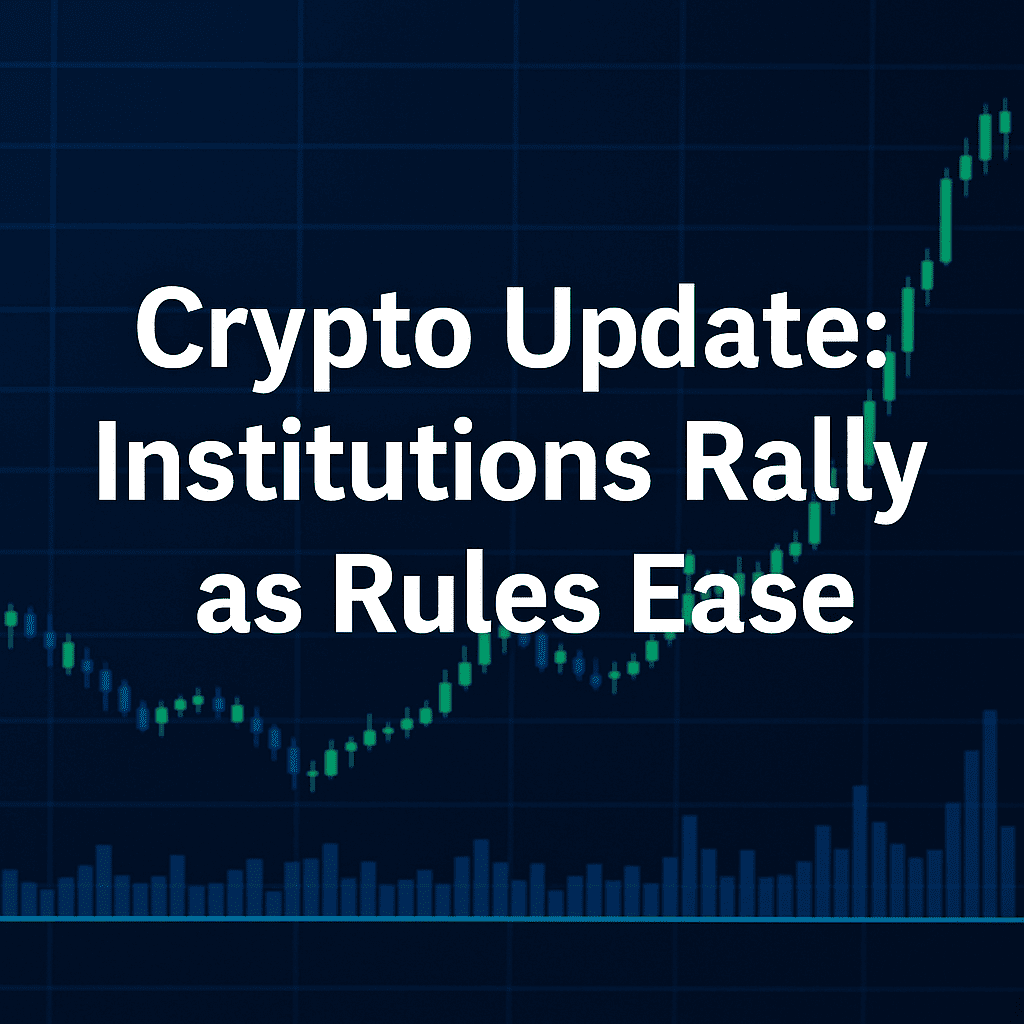

Crypto Update: Institutions Rally as Rules Ease

August 11, 2025 — The cryptocurrency market is experiencing one of its most significant turning points since the 2021–2022 bull cycle. The twin forces of institutional adoption and regulatory clarity are creating a rally that is both more mature in structure and broader in participation than previous waves.
Bitcoin is trading near all-time highs between $121,000 and $123,000, while Ethereum has decisively broken above $4,000, logging a 28% gain in August alone. Meanwhile, select altcoins are benefiting from sector-specific catalysts, from decentralized finance (DeFi) adoption to AI-driven blockchain utilities.
1. Institutional Adoption Hits a Milestone
The most significant catalyst this month came in the form of an executive order allowing U.S. retirement accounts—specifically 401(k) plans—to include cryptocurrency allocations.
What this means: For the first time, mainstream retirement vehicles can offer exposure to Bitcoin, Ethereum, and potentially other approved cryptocurrencies. This is a watershed moment, similar to the approval of Bitcoin ETFs in the early 2020s.
Immediate impact: Cryptocurrency Exchange-Traded Products (ETPs) saw $1.57 billion in net inflows last week—$268 million into Ethereum funds and $265 million into Bitcoin products. This is a sharp reversal from the outflows seen in Q2 2025.
Institutional investors are treating this as a green light to scale exposure, particularly in BTC and ETH, which are considered “blue chips” in the digital asset space.
2. Regulatory Clarity Reduces Uncertainty
For years, inconsistent regulatory frameworks have been the Achilles’ heel of crypto markets. That narrative is shifting:
The SEC’s “Project Crypto” initiative has outlined that most large-cap digital assets are non-securities, reducing the fear of retroactive enforcement actions.
Clearer pathways for listing and trading crypto ETPs are encouraging both institutional and retail participation.
Stablecoin legislation is now in effect, mandating full reserves and quarterly audits—a move seen as boosting trust in fiat-backed tokens like USDC and USDT.
Why this matters for retail investors: Less regulatory overhang means less downside risk from sudden legal shocks, making crypto allocation more predictable in diversified portfolios.
3. Ethereum’s Role as the Market’s Bellwether
While Bitcoin remains the dominant store-of-value play, Ethereum’s rally is noteworthy:
28% gain in August: Driven by both institutional inflows and optimism over Ethereum’s Layer 2 scaling ecosystem.
DeFi resurgence: On-chain data shows that DeFi protocols on Ethereum have seen a 40% increase in total value locked (TVL) over the past three months.
Tokenized assets: Ethereum’s smart contract network is underpinning experiments in tokenizing real-world assets, including bonds and real estate—further broadening its utility.
For retail investors, ETH offers both speculative upside and exposure to the growth of decentralized applications.
4. Retail Investor Dynamics: FOMO Meets Caution
The current market structure shows both similarities and differences compared to the 2017 and 2021 bull runs:
Similarities: Retail trading activity is surging, social media sentiment is heating up, and smaller-cap altcoins are seeing sharp intraday moves.
Differences: Institutional flows are now a stabilizing force, making this rally less dependent on retail-only hype cycles. Additionally, macroeconomic stability—paired with tech adoption—is underpinning the move.
Metrics like Bitcoin’s MVRV ratio (Market Value to Realized Value), now at 2.3×, suggest we’re in a relatively extended bullish phase, though not yet at the euphoric peaks of past cycles.
5. Altcoin Watch: Sector Rotation Emerging
Beyond BTC and ETH, capital is rotating into narrative-driven altcoins:
AI-linked tokens: Benefiting from the broader tech sector’s fascination with artificial intelligence.
Gaming/metaverse tokens: Seeing renewed interest as VR and AR adoption expands.
DeFi tokens: Gaining traction with higher yields and more robust platforms than in 2021.
Retail traders should note that while altcoins can produce outsized returns, they carry elevated volatility and liquidity risks.
6. Strategy for SCN Retail Readers
Given the evolving nature of the market, here’s a practical investment playbook:
Use Dollar-Cost Averaging (DCA): Enter positions gradually to smooth out volatility.
Allocate Wisely: Consider a core allocation to BTC and ETH (60–80% of your crypto exposure), with the remainder in high-conviction altcoin plays.
Set Targets and Stop-Losses: Protect gains and limit downside risk.
Stay Updated on Regulation: Changes in 401(k) access, ETP approvals, and tax policy can directly impact market sentiment.
Monitor On-Chain Data: Metrics like MVRV, funding rates, and TVL can signal when a rally is overextended.
Bottom Line
The 2025 crypto rally is being shaped by institutional legitimacy, regulatory progress, and retail re-engagement. While volatility will always be part of the crypto landscape, this market has stronger structural underpinnings than previous cycles.
For retail investors, the opportunity is real—but so are the risks. A disciplined approach, backed by ongoing market intelligence, will be the difference between catching the wave and getting caught in the undertow.
For immediate small cap and crypto market updates, subscribe here → SmallCapNetwork.com/subscribe
If you want, I can also create a side-by-side market sentiment chart comparing BTC, ETH, and altcoin index performance over the past month so SCN readers can see the momentum shifts visually. That would make the article even more engaging. Would you like me to prepare that?
Join our community to participate in comments, rate stocks, receive daily updates, and more.
SIMILAR ARTICLES
?